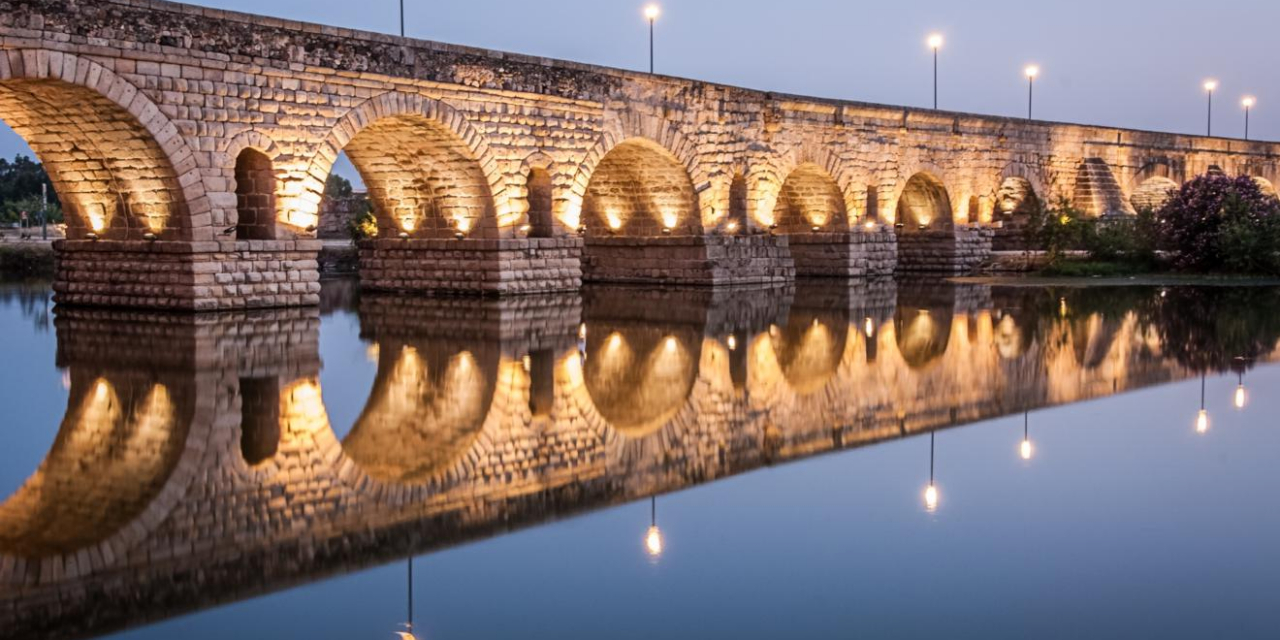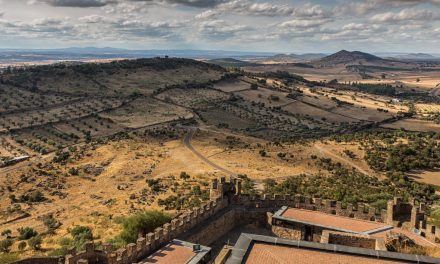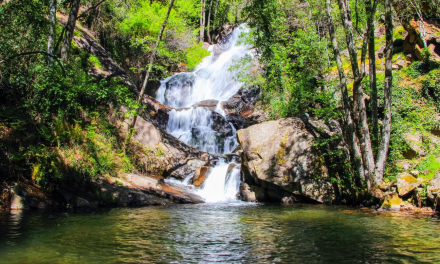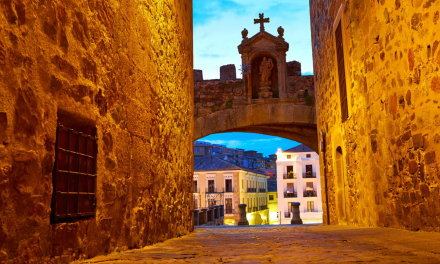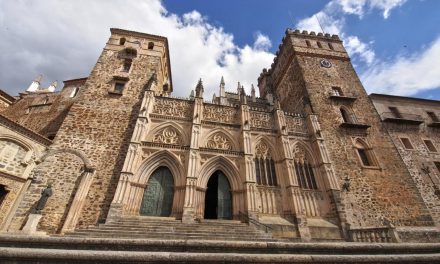Mérida deslumbra al viajero desde su estratégica ubicación en pleno eje de la Vía de la Plata y seduce a quienes la visitan con el incomparable decorado que dibujan las ruinas romanas, un histórico tesoro heredado de la rica ciudad amurallada en la que se levantaron foros, templos, termas y otras construcciones monumentales que hacen de la visita un regalo para los sentidos. En el año 1993, el Comité del Patrimonio Mundial de la UNESCO incorporó a la lista del patrimonio mundial el conjunto arqueológico de Mérida.

De la antigua colonia romana se conservan vestigios de su cuidado urbanismo: calzadas y calles, cloacas, diques, necrópolis, presas y puentes que enriquecen el Museo Nacional de Arte Romano, un edificio de nueva planta diseñado por el arquitecto Rafael Moneo que alberga más de 36.000 piezas que muestran el esplendoroso pasado de Emérita Augusta. Su glorioso legado se experimenta al adentrarse en el Teatro Romano, obra faraónica que tuvo capacidad para acoger a unos 6.000 espectadores y que hoy es el escenario en el que cada verano se desarrolla el Festival Internacional de Teatro Clásico de Mérida. En sus inmediaciones, se erigió en el siglo VIII antes de Cristo, el Anfiteatro Romano en el que aún se evocan los juegos de los gladiadores y la lucha entre animales salvajes en un marco gigantesco que tuvo capacidad para más de 15.000 espectadores.
La antigua Augusta Emérita evoca el pasado del emperador Octavio Augusto y de las legiones V Alaude y X Gemina, tiempos gloriosos del Imperio Romano que hoy se palpan en el majestuoso patrimonio de esta ciudad declarada Patrimonio de la Humanidad.
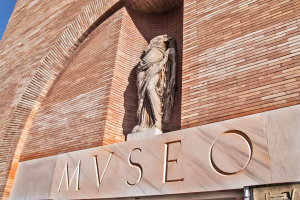
El acueducto de Los Milagros, el Circo Romano, el Templo de Diana, la Alcazaba Árabe, el Puente Romano, la Casa del Mitreo y el Arco de Trajano forman un conjunto de edificaciones que nos permiten realizar un viaje a la Mérida romana, visigoda y árabe. Hay tanto que contemplar que el viajero está obligado a planificar su viaje incluyendo otros elementos patrimoniales dignos de visitar, como la Basílica de Santa Eulalia, patrona de la ciudad, y “El Hornito”, oratorio dedicado a la Virgen.
La Plaza de España, el Puente Lusitania y el Palacio de Congresos y Exposiciones muestran la otra cara de la ciudad, la de una Mérida moderna y contemporánea, capital política, administrativa y cultural de Extremadura que apetece conocer en cualquier época del año. Con la llegada del estío, la experiencia Emérita Lúdica brinda al viajero la oportunidad de ser testigos, actores o figurantes de escenas cotidianas de la cultura romana que se desarrollan en el conjunto arqueológico monumental más completo y mejor conservado de Hispania. Luchas de gladiadores, ritos en el Templo de Diana o legionarios entrando por el puente son escenas que el viajero siempre conservará como parte de esta experiencia única.
La Semana Santa de Mérida, declarada de Interés Turístico Internacional y concebida en un marco monumental, moviliza a hermandades y cofradías que salen en procesión con algunos de los mejores escenarios que una celebración religiosa puede tener: el Arco de Trajano, el Templo de Diana o el Puente Romano. Y unas semanas después, este magnífico enclave se convierte en el plató cinematográfico en el que vivir y disfrutar del Carnaval Romano de Mérida, cuyo origen se remonta a las fiestas paganas que se realizaban en honor al Dios Baco o al Buey Apis.
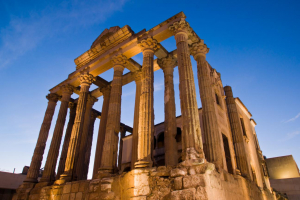
Destino gastronómico por excelencia, Mérida también rinde tributo al Dios del vino con atractivos restaurantes, gastro-bares y vinotecas que muestran la riqueza culinaria de la que ha sido Capital Iberoamericana de la Cultura Gastronómica. La riqueza de las Vegas del Guadiana y de la dehesa extremeña se unen en la capital extremeña, que ofrece recetas tan exquisitas como los apetecibles cojondongos y zorongollos. Gazpachos, embutidos y carnes del cerdo ibérico, quesos de cabra y oveja colorean una oferta en la que no faltan los ricos vinos de Ribera del Guadiana. Así se llega al solsticio de verano y Mérida acoge “Gastrosensaciones”, un universo de sabores, texturas y sensaciones para deleitar a los viajeros que han tenido la fortuna de elegir esta ciudad para pasar unos días de ocio que no olvidarán mientras vivan.

Mérida dazzles the traveller from its strategic position right on the Vía de la Plata and seduces those who visit it with its incomparable decoration sketched out by the Roman ruins, a historic treasure inherited by the wealthy, walled city where forums, temples, baths and other monumental constructions which make the visit a gift to the senses. In 1993, the UNESCO World Heritage Committee included the Mérida archaeological complex on the list of world heritage sites.
Vestiges of the meticulous urbanism of the ancient Roman colony are conserved: pavements and streets, sewers, dykes, necropolises, dams and bridges that enrich the Museo Nacional de Arte Romano – a modern building designed by the architect, Rafael Moneo and which holds more than 36,000 pieces that show the splendiferous past of Emérita Augusta. Its glorious legacy can be experienced on entering the Roman theatre, a pharaonic work which could hold up to 6,000 spectators and is nowadays the setting in which the Mérida International Festival of Classical Theatre is held. In the surrounding area, in the eighth century B.C., the Roman amphitheatre was erected and in which are still evoked the games of the gladiators and the fights between wild animals in an enormous setting which could hold over 15,000 spectators.
The ancient Augusta Emérita evokes the past of the emperor Octavio Augusto and of the V Alaude and X Gemina legions, glorious times for the Roman Empire which nowadays can be sensed in the majestic heritage of this city which has been declared a World Heritage site.
The Milagros Aqueduct, the Roman Circus, the Temple of Diana, the Arabic Citadel, the Roman Bridge, the Mitreo House and the Trajano Arch all form a complex of buildings which allow us to conduct a trip to the Roman, Visigoth and Arabic Mérida. There is so much to take in that the traveller must plan their journey including other heritage elements worthy of visiting, such as the Santa Eulalia Basilica, who is the city’s patron saint, and ‘El Hornito’ oratory dedicated to the Virgin.
Plaza de España, the Lusitania Bridge and the Palacio de Congresos y Exposiciones (congress and exhibitions hall) show the other side to the city, that of a modern and contemporary Mérida, a political, administrative and cultural capital of Extremadura which is appealing to get to know at any time of year. With the arrival of summer, the Emérita Lúdica experience gives the traveller the chance to be witness, actor or extra of daily scenes in Roman culture which are played out in the monumental archaeological complex which is the most complete and best conserved of Hispania. Gladiator battles, rituals in the Temple of Diana or legionnaires entering by the bridge are scenes the traveller will always remember as being a part of this unique experience.
Holy Week in Mérida, declared of international touristic interest (‘Interés Turístico Internacional’) and conceived in a monumental setting, puts brotherhoods and guilds into action who go out in processions with some of the best stages that a religious celebration can have: the Trajano Arch, the Temple of Diana or the Roman Bridge. And, one week later, this magnificent enclave becomes the film set where you can live and enjoy the Mérida Roman Carnival, whose origin dates back to the Pagan festivities which were held in honour of the God Bacchus or the Apis Bull.
A gastronomic destination par excellence, Mérida also pays tribute to the god of wine with attractive restaurants, gastro-bars and wine bars which show the culinary wealth for which it has been the Ibero-Americal Capital of Gastronomic Culture. The fecundity of the Vegas del Guadiana and of the Extremaduran meadows unite in the Extremaduran capital, which offers recipes as exquisite as the tasty ‘cojondongos y zorongollos’. Gazpachos (a cold, summer soup/refreshment), cooked meats and cuts of Iberian pork, goat and sheep cheeses colour a selection where the delicious Ribera del Guadiana wines couldn’t be absent. In this way, the Summer Solstice is reached and Mérida hosts ‘Gastrosensaciones’, a universe of flavours, textures and sensations to delight travellers who have had the good fortune of selecting this city to spend a few days of leisure that they won’t forget for the rest of their lives.


